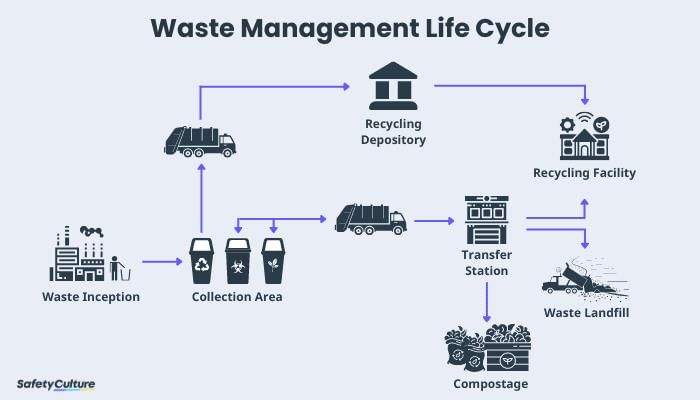Revision Notes: Waste Generation and Management | Biology Class 9 ICSE PDF Download
Waste Generation and Management

Waste refers to any substance that is discarded after its primary use, or is considered worthless, defective, and of no further use. Examples of waste include spoiled food, vegetable peels, leaves, wood, grass, paper, leather, cotton, and cattle dung.
Categories of Wastes
1. Domestic Waste: This type of waste is generated from household activities such as washing, bathing, and cooking. Examples include fruit and vegetable peels, leftover food, and waste paper. Sources of domestic waste include kitchen waste and plastics.
2. Industrial Waste: Waste generated by industries is known as industrial waste. Examples include chemicals, paint residues, oil, ash, sludge, and heavy metals. Sources of industrial waste include mining operations, cement industries, and oil refineries.
3. Agricultural Waste: Also known as farm waste or garden waste, this includes materials such as animal manure, plant leaves, bark, and flowers. Examples include residues of fertilizers, pesticides, and other chemicals. Sources of agricultural waste include agricultural residue and the use of pesticides and fertilizers.
4. Municipal Solid Waste: This type of waste is generated from domestic, industrial, and commercial activities. Examples include garbage, plastic bags, glass, metals, paper, rubber, and medical waste from hospitals and hotels. Sources of municipal waste include household discharges, public toilets, and both degradable and non-degradable wastes.
5. Electronic Waste: Discarded electrical appliances such as old televisions, computers, radios, mobile phones, fluorescent tubes, medical instruments, toys, and lead-acid batteries fall into this category.
6. Laboratory and Research Centre Waste: Waste generated in science laboratories and research centres includes broken or discarded glass equipment, waste chemicals, condemned machines, and plant and animal wastes from biology laboratories and culture rooms.
Methods of Safe Disposal of Wastes
A. Segregation
Segregation involves separating waste into three main categories:
- Reusable Waste: Items that can be reused, such as glass jars, plastic containers, and old clothes.
- Degradable Waste: Organic waste that can be composted, such as fruit and vegetable scraps, coffee grounds, and yard waste.
- Non-Degradable Waste: Items that cannot be broken down, such as plastic bags, polystyrene foam, and certain types of packaging.
Proper segregation helps municipal authorities to decompose and dispose of the organic part of the waste easily.
B. Dumping
Non-degradable wastes such as plastic, pesticides, and fibres can be dumped or buried in specially dug-up pits at locations far from human habitation.
C. Composting
Composting is the process of rotting and converting organic waste into manure, known as compost. The resulting compost improves soil fertility by providing essential nutrients.
- Household and Farmland Waste: Both types of waste can be converted into useful compost, benefiting the soil and reducing waste volume.
- Dry Composting Toilets: These toilets offer a hygienic and cost-effective solution for disposing of human waste.
- Segregation Challenge: Many people lack adequate knowledge about waste segregation at home, hindering the composting process.
D. Drainage/Sewer System
A sewer system consists of a network of pipelines that carry sewage from houses, offices, hospitals, and other establishments to the city’s sewer mains. The sewage is transported through drainage pipes to progressively larger pipes until it reaches a wastewater treatment plant.
E. Effluent Treatment Plants
Municipal and industrial wastewater is treated in effluent treatment plants before being released into water bodies. The treatment process includes:
- Primary Treatment: Large objects such as sticks, plastic packets, and cans are removed from the wastewater using bar screens.
- Secondary Treatment: A biological process is employed to remove dissolved and suspended organic matter from the wastewater.
- Tertiary Treatment: This chemical process involves removing dissolved chemicals, metals, and pathogens from the wastewater, varying based on its composition.
F. Incineration
Incineration involves burning waste at high temperatures, especially hazardous biomedical waste such as discarded medicines, toxic drugs, human anatomical waste, blood, pus, and microbiological waste.
- Benefits of Incineration: Reduces weight and volume of waste, converts toxic waste into less toxic substances, and generates electricity from the heat released during burning.
- Precautions: Incineration releases fumes and harmful substances, so it should be conducted at very high temperatures with pollution control devices in place.
G. Scrubbers
Scrubbers are devices designed to remove both gaseous and particulate matter from emissions.
Wet scrubbers are commonly used in industries such as chemical, metallurgical, and mining to capture pollutants like sulfur dioxide (SO2), ammonia (NH3), and metal fumes.
H. Electrostatic Precipitator
An electrostatic precipitator works by passing a gas or air stream containing dust, smoke, soot, and other particulate matter through a chamber with electrically charged plates.
These devices can remove up to 90% of particulate matter in thermal plants.
I. Disposal of E-Waste
Ragpickers and waste dealers collect discarded electronic gadgets, salvaging usable components and extracting secondary raw materials. However, this recycling process can pose various health risks, including cancer.
Most electronic goods contain a mix of materials and metals that can be recycled for future use.
If recycling is to be carried out, it must be done carefully and under skilled supervision to mitigate health risks.
|
18 videos|122 docs|19 tests
|















